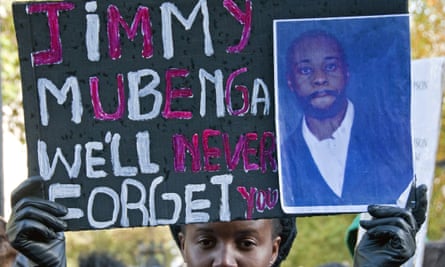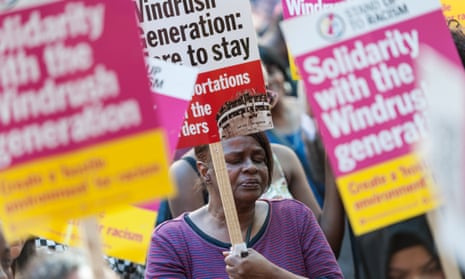Hundreds of people deported from the UK were restrained by a variety of methods including shackles, the Guardian has learned.
There were 447 cases where one or more forms of restraint were used between April 2018 and March 2019. Information on restraint using rigid bar handcuffs, leg restraints and waist restraint belts was provided to the Guardian in a freedom of information response.
Home Office policy states that there is a presumption against the use of restraint, but in 335 cases, the majority, more than one form of restraint was used at the same time. In 102 cases three different pieces of restraint equipment were used.
Home Office subcontractors that provide escorting services are trained in restraint procedures.
MPs and human rights campaigners condemned the evidence of widespread use of restraint during deportations. Labour’s David Lammy said the new data was chilling and revealed an abuse of power.
A report from her Majesty’s Inspectorate of Prisons published on Friday raised concerns about the use of restraint on a charter flight to Nigeria and Ghana earlier this year. It said: “Waist restraint belts were still being used on cooperative detainees for extremely long periods without them being given a chance to demonstrate compliance. It is unacceptable that this problem continues to occur despite promises of remedial action.”
A previous report last year condemned the excessive use of restraint on another charter flight, when 22 of 23 passengers were held in waist restraint belts even though most had no history of disruption and were deemed low risk.
Deportees on the charter flight to Jamaica in February this year, one of the Home Office’s most recent charter flights, told the Guardian that everyone had been restrained for at least part of the journey. A Home Office spokesman declined to comment on the arrangements for that flight.
Much of the restraint used during deportations takes place on Home Office-commissioned charter flights.
Lovelyn Edobor, a disabled Nigerian victim of trafficking, said that when the Home Office tried to deport her in 2017 she was placed in a waist restraint belt attached to a long chain and dragged along.
Home Office officials said a full review of the department’s Homes manual on safe escorting was under way to ensure that current techniques were still the most effective.
Much of the guidance about restraint during deportation follows the death of Jimmy Mubenga in 2010. The Angolan suffered cardio-respiratory collapse caused by restraint and an inquest jury found that he had been unlawfully killed, in a case revealed by the Guardian. The technique of pushing his head down hard so that any noise he made was directed toward the floor was nicknamed carpet karaoke.

Home Office guidance drawn up in 2016 and which officials say is still current emphasises the need for risk assessments to be carried out before restraints are applied.
Restraint should be carried out in a way that “preserves the dignity of the detainee”, but elderly, infirm and terminally ill people are not automatically exempt. A risk assessment is meant to determine whether restraining such people could amount to “inhuman and degrading treatment”. The same applies to pregnant women and people with disabilities, including those using crutches.
Restraint is not only an option for those who may be violent or disruptive but also for those who have medical or mental health risks, and those who have made self-harm or suicide attempts. The guidance states: “An escort chain may be used when necessary. If the escort chain is used in public it must be kept as short as possible to make its use inconspicuous.”
There are various options with a waist restraint belt. It can leave hands and arms free or restrict hand and arm movement partially or entirely. Waist restraint belts should ideally be applied when people are compliant, but if they are not compliant it should be applied in a kneeling position.
In certain circumstances “approved Homes pain compliance techniques may be used to assist in the application of the waist restraint belt”.
A report by the Independent Panel on Non-Compliance Management assessed the risks of injury as a result of different types of restraint equipment. Waist and leg restraints were deemed low or very low risk, although overtightening the strap of the leg restraint could impede circulation and overtightening the waist restraint could heighten risks for an obese person.
The report said: “The use of the waist restraint belt and leg restraints together render the subject immobile. If a person was carried in this state there were ‘significant risks’ and that if the person was dropped the ‘consequences could be catastrophic’. Use of handcuffs poses a low risk of fractures and a significant risk of bruising or other soft tissue injury to the wrist.”
Lammy said: “This paints a hugely chilling picture that appears to go far beyond reasonable and proportionate force. The ancestors of many of those who find themselves on these flights were once put in chains and shackles too. This abuse of power is utterly shameful and future generations will look back on it with horror.”
Emma Ginn, the director of Medical Justice, which works for health rights for detainees, said: “Medical Justice has been reporting on instances of restraints during removals since 2005.
“Our independent volunteer doctors who visit immigration detainees continue to document injuries caused by guards and inappropriate use of restraints during attempts to remove vulnerable detainees.”
A Home Office spokesperson said: “The dignity and welfare of all those in our care is of the utmost importance, as is the safety of individuals and those around them.
“We keep the use of restraint during escorted removals under review and we look at all removals where force is used to ensure that techniques are used proportionally, that they are justified, and are used for the minimum period required.”
‘Being restrained brought back all the trauma’
Najat Ibrahim Ismail, 32, an Iraqi Kurd, was prosecuted for assisting unlawful immigration into an EU member state. He brought his baby niece to the UK from a French refugee camp in January 2016 because she had sustained serious burns there. The Home Office has tried to deport him to Iraq three times in recent months.
He was restrained with a waist restraint belt and handcuffs during two of the attempts, but he says he was not violent to the escorts. He was on the airport runway with the escorts at the time.
Ismail has been diagnosed with PTSD as a result of the trauma he suffered in Iraq compounded by his time in immigration detention. He is married to a British woman, Emma Ismail, and has three young British children, including a 10-year-old son with autism.
“I was sitting very still and I was crying because I was scared about being deported,” he said. “The feeling you get when you’re placed in handcuffs and the waist restraint belt is indescribable.
“It made me feel as if I was a killer although I have never committed a crime like that. They put the waist restraint on you, then they put your hands into it and you’re chained to an escort on the left and the right.
“I didn’t move because I thought if I did I might get injured. I just sat quietly and prayed. The whole thing felt so humiliating.
“I’m happy that my deportations were cancelled and that now I’m back with my wife and kids but being restrained like a killer brought back memories of all the trauma I experienced before.”









